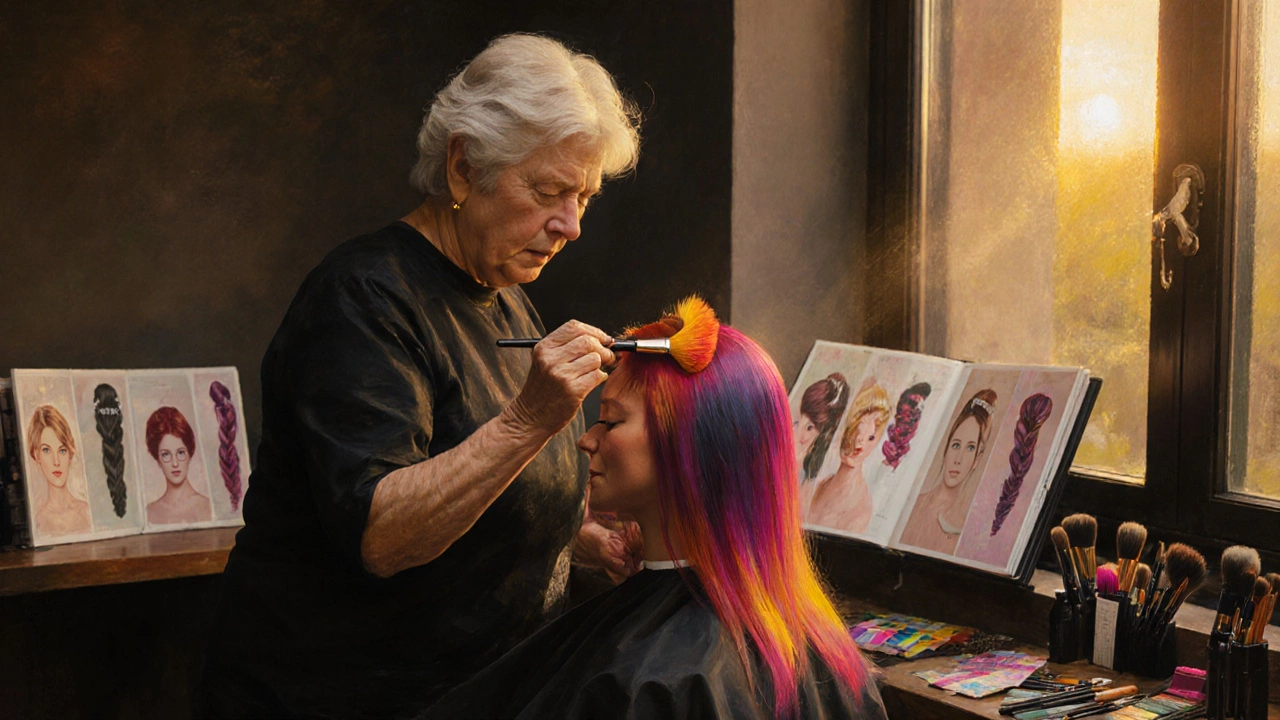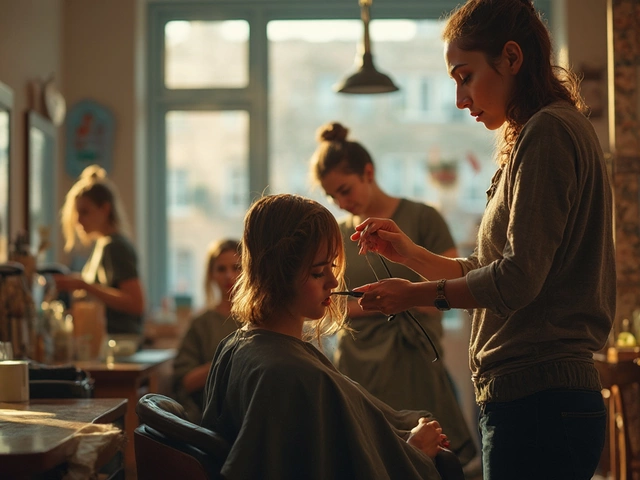Hair Professional Title Checker
Choose Professional Role
Select the primary service and qualification level to find the correct professional title
Select your options and click 'Check Professional Title' to see the correct professional designation.
Ask anyone what you call a woman who cuts hair, and most will say hairdresser. But that’s not the whole story. In salons across Bristol, London, and beyond, you’ll hear different names used - stylist, barber, cutter, technician. Why the confusion? Because the job has changed, and so have the titles. What you call someone matters. It tells you their training, their skills, and even how they see themselves.
It’s Not Just ‘Hairdresser’ Anymore
The word ‘hairdresser’ has been around for over a century. It was once used for anyone who washed, styled, or cut hair - mostly women. But today, that term feels too broad. A woman who cuts hair might specialize in precision fades, bridal updos, or color correction. Calling her just a ‘hairdresser’ is like calling a surgeon a ‘body fixer’. In professional settings, the most accurate title is hair stylist. This term covers cutting, coloring, texturizing, and styling. It’s what you’ll see on salon websites, business cards, and NVQ Level 2 and 3 qualifications in the UK. The City & Guilds and VTCT awards don’t list ‘hairdresser’ as a job title - they list ‘hairdressing stylist’.Barber or Stylist? The Line Has Blurred
Here’s where things get tricky. Many women now work in barbershops. They cut men’s hair, shape beards, and use clippers like pros. So are they barbers? Yes - if they’ve trained in barbering. Barbering is a separate qualification in the UK. It focuses on short hair, fades, line-ups, and men’s grooming. A woman who completes a Level 2 Barbering course is legally a barber, no matter her gender. You’ll find women barbers in shops like The Gents Club in Bristol and The Cut in Manchester. They don’t call themselves ‘female barbers’ - they’re just barbers. The trade doesn’t care about gender. It cares about skill. The British Barbering Association confirms that over 30% of new barbering students in 2024 were women.What About ‘Hair Cutter’?
Some people use ‘hair cutter’ as a simple, no-frills term. It’s not wrong - but it’s not professional either. You won’t see it on a CV or a salon sign. It sounds like a side job, not a career. In formal training, no qualification uses ‘hair cutter’ as a title. Even in apprenticeships, students are trained to become stylists or barbers - not cutters. If you’re hiring or choosing a professional, avoid the term ‘hair cutter’. It doesn’t tell you anything about their training, experience, or ability to handle color, perms, or complex textures.
Titles That Actually Matter in the Industry
In salons, titles are tied to qualifications. Here’s what you’ll really see:- Junior Stylist - Newly qualified, works under supervision, usually NVQ Level 2
- Stylist - Fully qualified, can work independently, NVQ Level 3
- Senior Stylist - 3+ years experience, trains juniors, often specializes in color or texture
- Master Stylist - 7+ years, teaches courses, works with brands, often has a following
- Barber - Holds a Level 2 or 3 Barbering qualification, specializes in short hair and grooming
- Color Technician - Focuses only on hair color, may not cut hair at all
Why the Right Title Helps You Choose the Right Pro
If you’re looking for a woman to cut your hair, here’s what to look for:- Want a clean, modern trim or fade? Look for a barber - even if she’s a woman.
- Need layers, texture, or a style that lasts weeks? Go for a stylist.
- Want to change your hair color dramatically? Ask if they’re a color technician first.
- Looking for a bridal updo or event styling? Make sure they’ve done it before - ask for a portfolio.

How to Become One
If you’re thinking of cutting hair for a living, here’s how it works in the UK:- Start with a Level 2 Diploma in Hairdressing (City & Guilds or VTCT). This covers basic cutting, washing, and styling.
- Move to Level 3 - this is where you learn advanced cutting, coloring, and client consultation.
- Optional: Take a Level 2 Barbering course if you want to specialize in men’s hair.
- Build your portfolio. Work in a salon. Learn from senior stylists.
- After 2-3 years, you can become a senior stylist or even teach others.
Common Myths About Women in Hairdressing
There are a few old ideas that still float around:- Myth: Only men can be barbers. Truth: Women have been barbers since the 1970s. The trade opened up fully in the 2000s.
- Myth: Hairdressers just wash and blow-dry. Truth: A good stylist knows anatomy, chemistry, and client psychology.
- Myth: Women can’t handle clippers. Truth: Many female barbers use clippers better than most men.
Final Answer: What Do You Call a Woman Who Cuts Hair?
The best answer? It depends. - If she’s trained in general hairdressing → hair stylist - If she’s trained in men’s short cuts and grooming → barber - If she only does color → color technician - If she’s just starting out → junior stylist Don’t say ‘hairdresser’ unless you’re talking casually. In professional circles, it’s outdated. And never say ‘hair cutter’ - it doesn’t carry weight. The right title tells clients you know what you’re doing. It tells employers you’ve trained properly. And it tells other professionals you take your craft seriously.Is a hairdresser the same as a stylist?
In casual use, yes. But professionally, no. ‘Hairdresser’ is an old term that covers washing, styling, and cutting. ‘Stylist’ is the modern, qualified title used in NVQ courses and salons. A stylist has advanced training in cutting techniques, color theory, and client consultation. Most employers now require ‘stylist’ on CVs.
Can a woman be called a barber?
Absolutely. If a woman completes a Level 2 or Level 3 Barbering qualification, she is legally and professionally a barber. Gender doesn’t matter in the trade. Many women now run successful barbershops and specialize in fades, tapers, and beard shaping. The British Barbering Association reports that over 30% of new barbering students in 2024 were women.
What’s the difference between a stylist and a colorist?
A stylist cuts, styles, and may do color. A colorist specializes only in hair color - highlights, balayage, corrections, toning. Many salons have separate colorists because it’s a highly technical skill. A colorist might not cut hair at all. They often train for years to master pigment chemistry and scalp health.
Do I need a qualification to cut hair professionally?
Yes. In the UK, you must hold a recognized qualification - usually NVQ Level 2 or 3 in Hairdressing or Barbering - to work in a salon legally. Without it, you can’t get insurance, rent a chair, or be hired by most salons. Even freelance stylists need certification. It’s not optional - it’s the law.
What’s the best path to becoming a senior stylist?
Start with a Level 2 Hairdressing course, then move to Level 3. Work in a busy salon for at least 2 years. Ask to assist senior stylists. Take extra courses in color, extensions, or texture. Build a portfolio. After 5-7 years, you’ll be ready for senior roles. Many go on to teach or open their own salons.





Write a comment